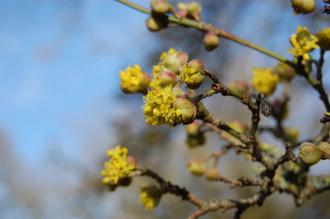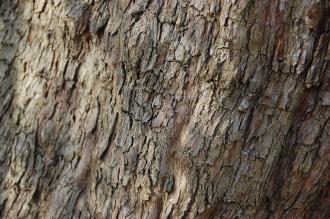
Cornus officinalis (08/02/2015, Kew Gardens, London)
Position: Full sun to dappled shade
Flowering period: Early spring
Soil: Moist, well drained
Eventual Height: 10m
Eventual Spread: 10m
Hardiness: 6a, 6b, 7a, 7b, 8a, 8b, 9a
Family: Cornaceae
Cornus officinalis is a large shrub or small tree that has an open, spreading habit. Its dark green leaves are ovate to elliptic with entire margins, up to 10cm long and 4.5cm broad. Its leaves may turn yellow/ red/ purple in autumn before they fall. Its bark is grey/ brown. Its yellow flowers are star shaped, up to 2cm across and appear in umbels before the plant comes into leaf. Its red fruit is an ellipsoid drupe, up to 18mm long, 7mm across and are produced in autumn.

Cornus officinalis Flower Buds (08/02/2015, Kew Gardens, London)
Cornus officinalis, commonly known as the Cornelian Cherry, Japanese Cornelian Cherry or Japanese Cornel, is native to Korea, Japan and China. In its native habitat it grows in deciduous woodlands.
The etymological root of the binomial name Cornus is derived from the Latin cornus meaning ‘horn’, due to its dense properties and was originally the old name for this plant. Officinalis is from the Latin meaning ‘of the shop’.
The landscape architect may find Cornus officinalis useful as an attractive spring flowering large shrub or small tree which also has attractive autumn color.
Ecologically, Cornus officinalis berries are eaten by some mammals and many birds. The leaves provide food for some moths and caterpillars. The flowers are attractive to pollinating insects.

Cornus officinalis Bark (08/02/2015, Kew Gardens, London)
The Royal Horticultural Society has given the variety Cornus officinalis ‘Kintoki’ their prestigious Award of Garden Merit in 2012.
Cornus officinalis prefers moist, fertile, well-drained soils. It tolerates most pH of soil, including very alkali soils.
Cornus officinalis requires little maintenance. Pruning should be carried out during the winter months.

